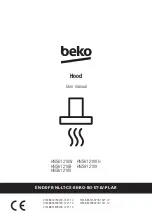
3.7
C
ONNECTING
I
NSULATED
D
UCTS
TO
E
XTERIOR
PORTS
•
For each exterior port, using a jig saw, cut a 5’’ diameter hole in the
exterior
wall.
•
From the outside, slide the exterior port in place and attach it to the
exterior wall, using 2 no. 8 x 1½” provided screws. Seal the outline with
silicone.
• From the inside, pull back the insulation to expose the flexible duct and,
using a tie wrap, attach it to the exterior port rigid duct. Carefully seal
with duct tape. Pull the insulation over the joint. Pull the vapor barrier
over the insulation and over the joint. Apply gently duct tape to the joint
making an airtight seal. See illustration at right.
VR0028
Choose an appropriate location for installing the exterior ports:
•
There must be a minimum distance of 6’ (1.8 m) between the hoods to avoid cross-contamination
•
There must be a minimum distance of 18” (457 mm) from the ground
3.6.2 L
OCATING
E
XTERIOR
P
ORTS
VD0203
Make sure the fresh air intake port is located at least 6 feet (1.8 m) away (or more, as per applicable building
codes or standards) from sources of contamination such as:
• Dryer exhaust, high efficiency furnace vent, central vacuum vent
• Gas meter exhaust, gas barbecue grill
• Garbage
bin
• Any exhaust from a combustion source
WARNING
!
6’
(1.8
M
)
6’
(1.8
M
)
S
TALE
AIR
EXHAUST
PORT
18’’
(457
MM
)
18’’ (457
MM
)
5’’ Ø
(127
MM
)
5’’ Ø
(127
MM
)
F
RESH
AIR
INTAKE
PORT
O
PTIONAL
LOCATION
3. I
NSTALLATION
(
CONT
’
D
)
3.6
I
NSTALLING
I
NSULATED
F
LEXIBLE
D
UCTS
(
CONT
’
D
)
10










































